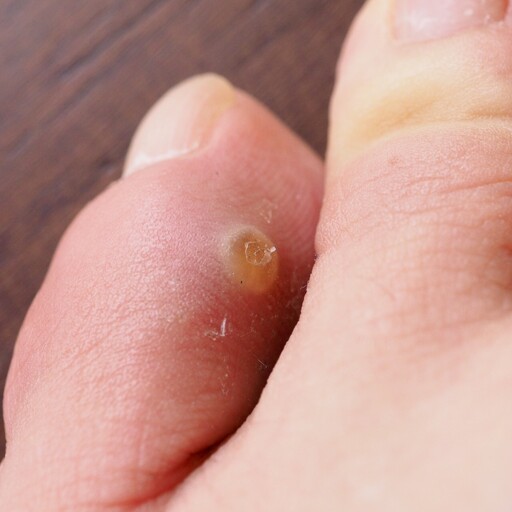Corns
Like calluses, corns are thickened areas of skin that are usually hard and circular-shaped, with a polished or translucent centre, like the kernel of corn from which they take their name. They may become painfully inflamed in response to persistent excessive pressure or friction, or infected and ulcerated when they rub against one another.
Signs & Symptoms
Sufferers commonly describe sharp, severe burning-type pain, sometimes a deep aching, at the affected areas. Corns commonly occur on the top of toes and often between the little toe and its neighbour. They can also appear on the bottom or side of the foot - normally on weight-bearing areas. While corns can be perceived as a minor disorder, corns can produce severe pain, prevent the use of footwear, walking and standing and people’s ability to live normally.
Causes
A corn is an excessive growth of skin that forms in response to excessive pressure and friction.
Like the rest of our body, the bones in our feet are covered in soft tissue. The most superficial layer is called the epidermis. The epidermis at the souls of your feet and palms of your hands has five layers. As you move deeper, the epidermis joins the dermis. Moving deeper still, the dermis meets subcutaneous fat and at the deepest level, bone. Connective tissues, blood vessels and nerve tissues are also involved with this soft tissue covering. When continual, localised pressure is applied upon your toe or an area on your foot, the skin cells at deepest layer of the epidermis, called (basal cells), become irritated.
Epidermal basal cells make skin cells. They normally take 14 days to migrate upwards from the basal cell level up to the surface of your skin and another 14 days to rub off as dead cells forming house dust.
Irritation of these basal cells, caused by abnormal pressure, causes them to produce more new cells within this 28 day cycle. These rapidly forming cells don’t have time to rub off and instead stack up at the surface of your skin. The pressure prevents them from forming a bump or built up cells and instead they start to migrate inwards, forming a hard cone shaped dead keratinous structure, pointing sharply downwards. This hard shaped cone then pushes downwards onto underlying nerve structures that illicit a pain response, often a sharp, neuralgic type pain.
This type of hard corn is referred to as a Heloma Durum. When this type of corn occurs in-between toes, the moisture within this web space often causes the corn to soften, appearing whitish. This soft type of corn is referred to as a Heloma Molle, (the French call it a kissing corn).
Corns can also be caused by an abnormality of the way in which skin produces new skin cells. This can result in corn type structures being formed in areas that do not suffer from excessive pressure.
There are also corns that can form due to a viral infection of the epidermis that cause an abnormal basal cell metabolism. These may be larger lesions that can also cause significant pain.
Sometimes long standing corns develop their own blood and nerve supply - neurovascular corns. They are often significantly painful and also require specialist podiatrist treatment.
Diagnosis
There are many different types of corn and a precise diagnosis is the cornerstone of all safe and effective podiatric treatment.
Our specialist podiatrist, Stefan, is also a registered Podiatric Radiographer. He is able to provide you with a specialist podiatrist consultation where an effective treatment management plan can be discussed. This may include the use of the latest advanced podiatric diagnostic equipment.
When necessary, he is able to utilize the latest advanced medical diagnostic equipment to help determine the cause of your corn. This can include the use of a low dose Mini C-arm X-Ray and Fluoroscopic investigation and the use of a colour Doppler Ultrasound.
Treatment
PLEASE DO NOT USE MEDICATED CORN PADS. THEY ARE DANGEROUS AND CAN CAUSE HARM.
The treatment of corns relies upon gaining a correct diagnosis. Our specialist podiatrist, Stefan, can offer you an in-depth examination and diagnose the cause of your corn. He can then provide you with a treatment plan aimed at offering you long-term pain relief.
This can include, but is not limited to:
A regime of routine palliative care aimed at debriding the corn, offering pain relief.
If necessary, recommendations of footwear shape and design may be given.
The manufacture of custom inter-digital devices. These are designed to relieve pressure and pain for corns located in between your toes, slowing down the reoccurrence of these painful corns.
The design and manufacture of prescription insoles designed to fit within dress type shoes and offer precise pressure and pain relief from your painful corns located at the bottom of your feet.
The design and manufacture of prescription orthotics that support the entire foot. Ideally suited for active people who spend hours on their feet standing and for those who enjoy walking, running, skiing, hiking and cycling. These can redirect pressure away from painful corns on the bottom and side of the foot. They also help to correct the way you walk; relieving foot, ankle, knee, hip, back and neck pain.
Sometimes stretching exercises can be given to help straighten out deformed toes or to increase the flexibility of the calf muscles and in doing so, reduce pressure from painful corns underneath the forefoot.
These are just a few examples of the corn treatments that our specialist Podiatrist, Stefan, can offer.
If you suffer from painful corns, please contact us, we can help.
Prevention
PLEASE DO NOT USE MEDICATED CORN PADS. THEY ARE DANGEROUS AND CAN CAUSE HARM
Corns can often be caused by excessive, localised pressure, so the removal of that pressure will help alleviate the pain that can be associated with the corn and the formation of the corn.
Check your shoes. Make sure that they fit the shape of your foot. Often a simple change from a “pointy” shaped shoe to a round-toed, foot-shaped shoe is all that is required to give relief.
If you feel your corn is located in-between your toes, you can try using Hiker’s Wool. Place a small amount of Hiker’s Wool in between the painful toe before wearing socks and shoes. This can help relieve pressure and prevent the corn form developing.
If you feel that a corn may be developing on top, at the end of your toe, or underneath your foot, you can use a good quality moisturiser to regularly apply to the area. We recommend a product called Foot Wax from our sister company www.thefootshop.co.nz.
You can also use pumice. Gently apply the Foot Wax and gently remove small parts of the hardened skin. Please be careful and remember less is more. Over-use of the pumice can cause more pain and risk damaging healthy skin, causing a painful graze or infection.
If you are still in pain, contact our rooms so that Stefan, our specialist podiatrist, can offer you safe and sensible advice.

